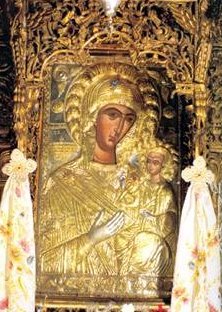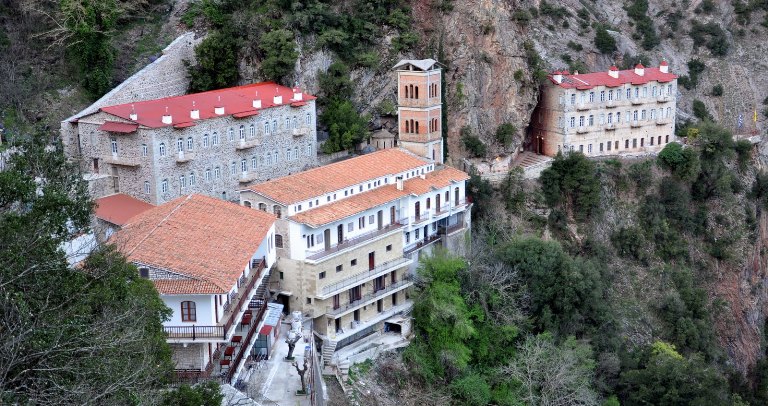
A lot of people call it “The house of Virgin Mary” because, according to some traditions, the Monastery of Prousos in Evritania (Central Greece) was built at the exact place which Virgin Mary chose in a miraculous way.
The historic complex, that dates back to 829AD, is located 35kms away from Karpenisi. On the path that leads to the Monastery there are the “footsteps of Theotokos” (Patimata tis Panagias). They are seven shapes of different colours each, which, according to some traditions, are the traces Virgin Mary left on her way to Proussos, on the rock that stands there.
According to some traditions, the icon of Virgin Mary that was created by the Evangelist Lukas was taken away from Proussa of Asia Minor in 829AD, during the period of Iconomachy, so as to be saved from the burning of the byzantine icons that the Emperor Theophilos had ordered. The icon was transferred to Greece by a young man whose name was Dionysios, but for an unknown reason, the icon was lost when he arrived to Thrace.

After Thrace, the icon appeared in Evritania, where it was revealed to a shepherd as a bright pillar that reached the sky. This happened on 23rd August and this is the date when the icon is celebrated, as it was set by the Monastery where it was transferred, as it was considered that this was the place where Virgin Mary chose in order to “reside”.
According to the records of the Monastery, several parts of the icon were destroyed during Turkish occupation. More recently, the German invasion to the Monastery on 16th August 1944, led to the complete destruction of its buildings. According to some testimonies, an officer wanted to burn the church too but he never managed it. He was prevented by the “invisible hand” of Virgin Mary, as he felt a strong power pushing him down to the floor, as he was giving orders.
The icon of Panagia Prousiotissa is miraculous and for this reasons a lot of believers from Greece and abroad come there. Moreover, the silver cover of the icon was donated to the Monastery by G. Karaiskakis, because he wanted to be cured from a disease he was suffering from when he was housed into the Monastery at the times of the Revolution. The cell of the Monastery where Karaiskakis lived exists until today. The Monastery had been destroyed a lot of times. The most recent destruction occurred in 1944, when the Germans intruded into the Monastery.
The Monastery consists of the Catholicon, in which restoration works have taken place, and a wing of cells. The Catholicon is a cross-shaped temple with a dome and in the western part there is a crypt that serves as a chapel. The temple dates back to 1754AD and in the external part of the crypt murals that date back to the 13th century have been saved.
Opposite the Monastery, there is the chapel of Agioi Pantes that was built in 1754, and near them there is also the building of the Faculty of Letters that was built in 1820 by Dositheos, the Bishop of Litza and Agrafa.
Today, in the Monastery there are two three-floored guesthouses for hosting pilgrims, a museum of ecclesiastical findings and objects as well as a museum of the Greek Letters of Roumeli.
The opening hours for the public are from 09.00-13.00 and from 15.00-17.00.
Tel.: (+30)22370-80726
You can also watch this video from the great programme of the channel ΕΡΤ3. The name of the programme is “Iera Monopatia” (Holy Paths).
https://www.youtube.com/watch?v=FUqEDAvfzdI











